When you think of water-loving birds in Louisiana, you’re probably thinking of the state’s many beloved shorebird species. Birds like rails, plovers, skimmers, the Bald Eagle, and Louisiana’s state bird, the Brown Pelican.
But what you might not be thinking of is another bird family that loves water and loves Louisiana: the blackbirds.
Most blackbird species are known for loving water-filled habitats like wetlands, marshes, and bogs. North America’s Louisiana has a lot to offer these birds!
You might expect that a family of blackbirds would be named for its black feathers, but when it comes to their scientific name, Icteridae, they’re actually not.
The name “Icterid” means “the jaundiced ones,” which sounds none-too-flattering! It refers to the flashy yellow feathers that many members of the blackbird family also have.
In addition to these bright yellow feathers, many blackbirds have extremely colorful bodies, thanks to their natural iridescence. Their black feathers can show flashes of many other colors, including ranges of blues, greens, and purples.
Let’s find out more about Louisiana’s varied and fascinating blackbirds.
Western Meadowlark
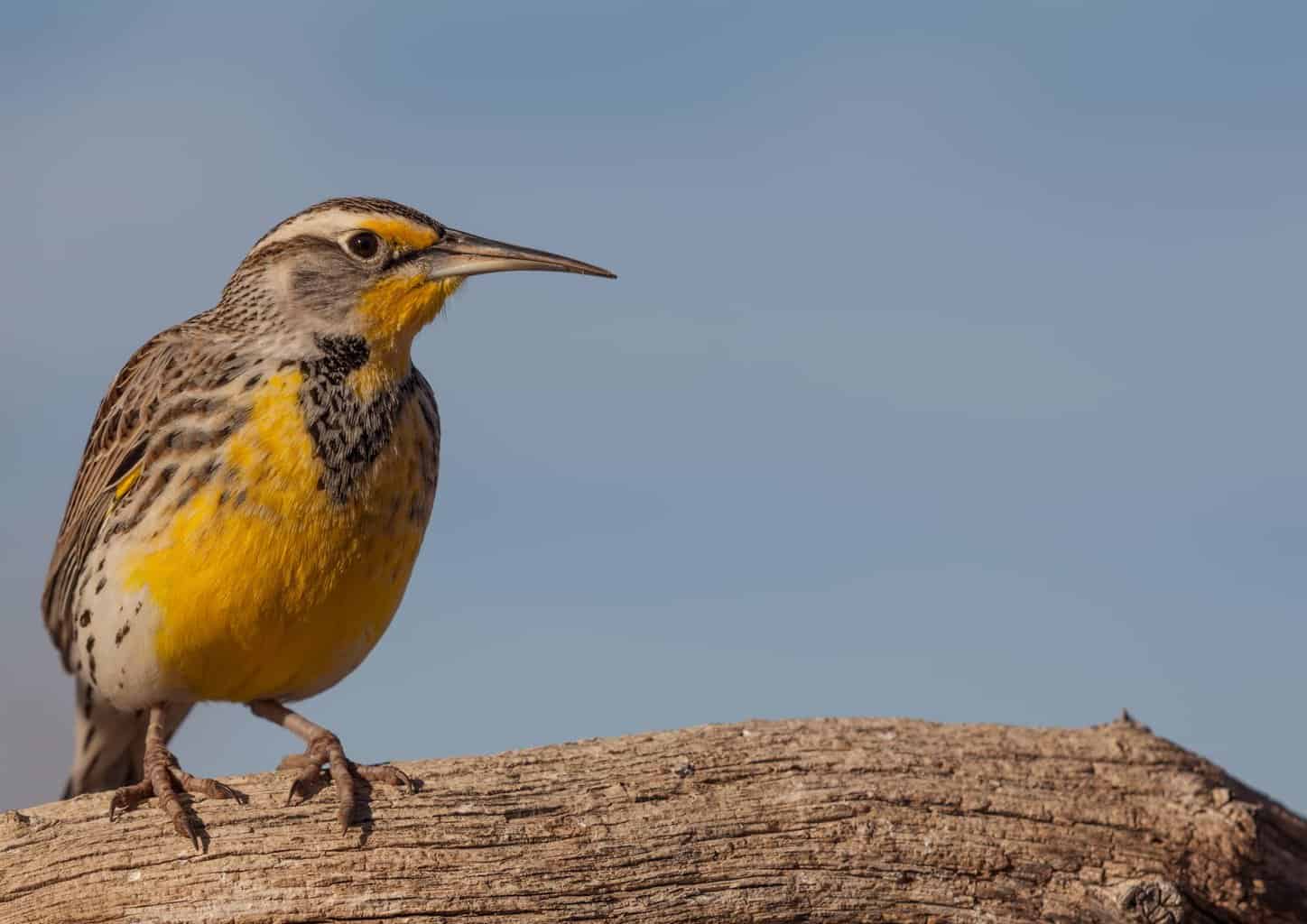
- Length: 6.3 – 10.2 in (16 – 26 cm)
- Weight: 3.1 – 4.1 oz (89 – 115 g)
- Wingspan: 16.1 in (41 cm)
Color Pattern: Western Meadowlarks have bright yellow undersides, with a distinctive black V at the breast that turns gray in winter. The rest of the body has detailed patterning in brown, black, and cream.
The head is striped in dark brown and cream, and the outer tail feathers look white in flight.
The Western Meadowlark had some famous friends. It was first noted by the explorer Merriweather Lewis that this bird was different from its Eastern counterpart.
John James Audubon was the one to bestow its scientific name, Sturnella neglecta.
This bird’s appeal has continued to the present. The Western Meadowlark is the second most popular state bird, representing six states, surpassed only by the Northern Cardinal, which represents seven.
Eastern Meadowlark
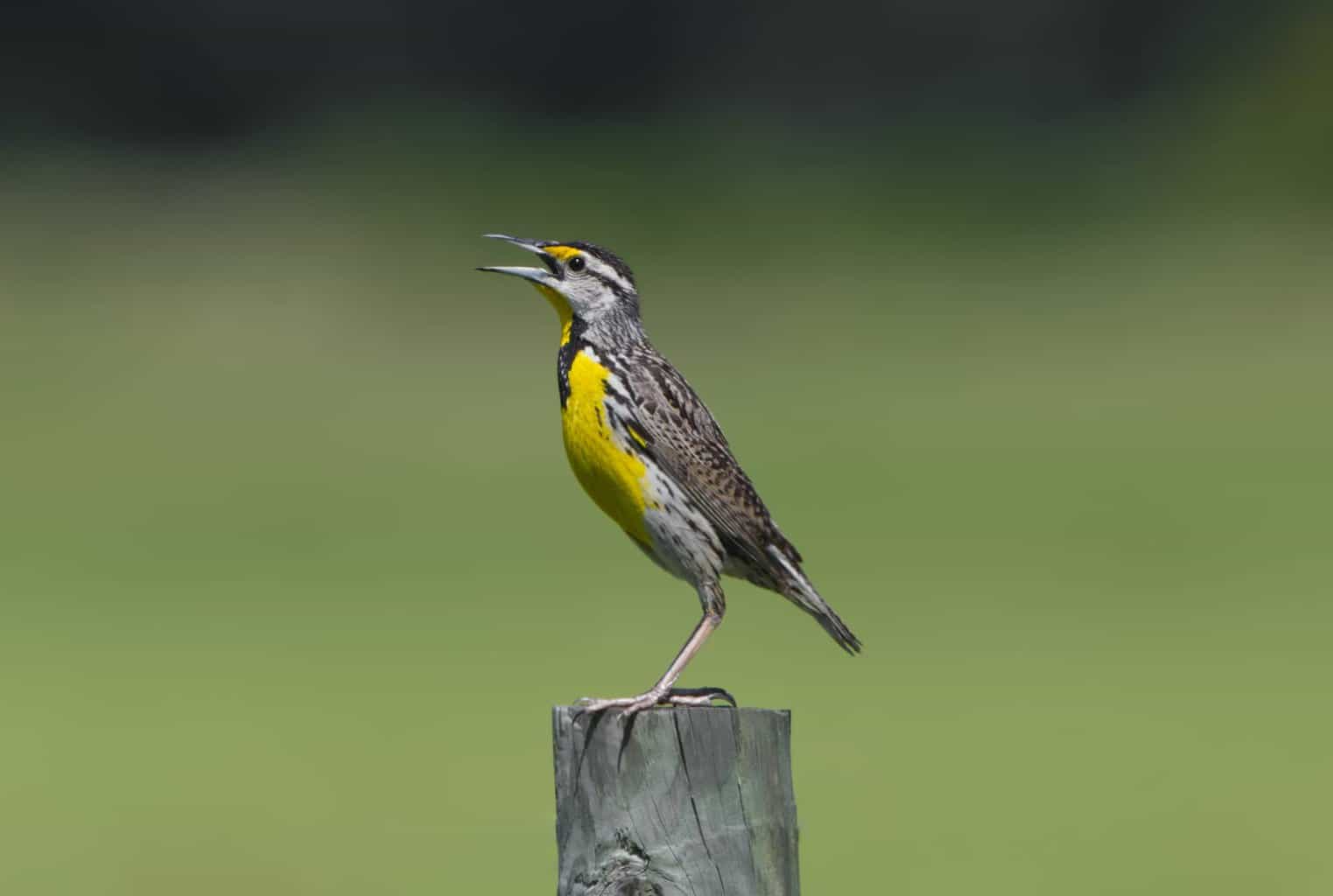
- Length: 7.5 – 10.2 in (19 – 26 cm)
- Weight: 3.2 – 5.3 oz (90 – 150 g)
- Wingspan: 13.8 – 15.8 in (35 – 40 cm)
Color Pattern: Eastern Meadowlarks have a sunny yellow breast with a distinctive black v-marking at the chest. The rest of the body is pale brown with black markings.
The tail is brown with blackish barring, and white outer feathers that become noticeable during flight.
The Eastern Meadowlark may be a little more mysterious than your average blackbird. They’re not as common to see at bird feeders because they prefer grassy fields and exposed perches like treetops.
It’s also not easy to find an Eastern Meadowlark’s nest: these birds will walk back to their nests rather than fly.
Even though Eastern and Western Meadowlarks may look nearly identical, they’re definitely separate species that do not hybridize readily.
When they encounter each other in the wild, they have different birdsong “languages,” and will fight fiercely for territory.
Orchard Oriole
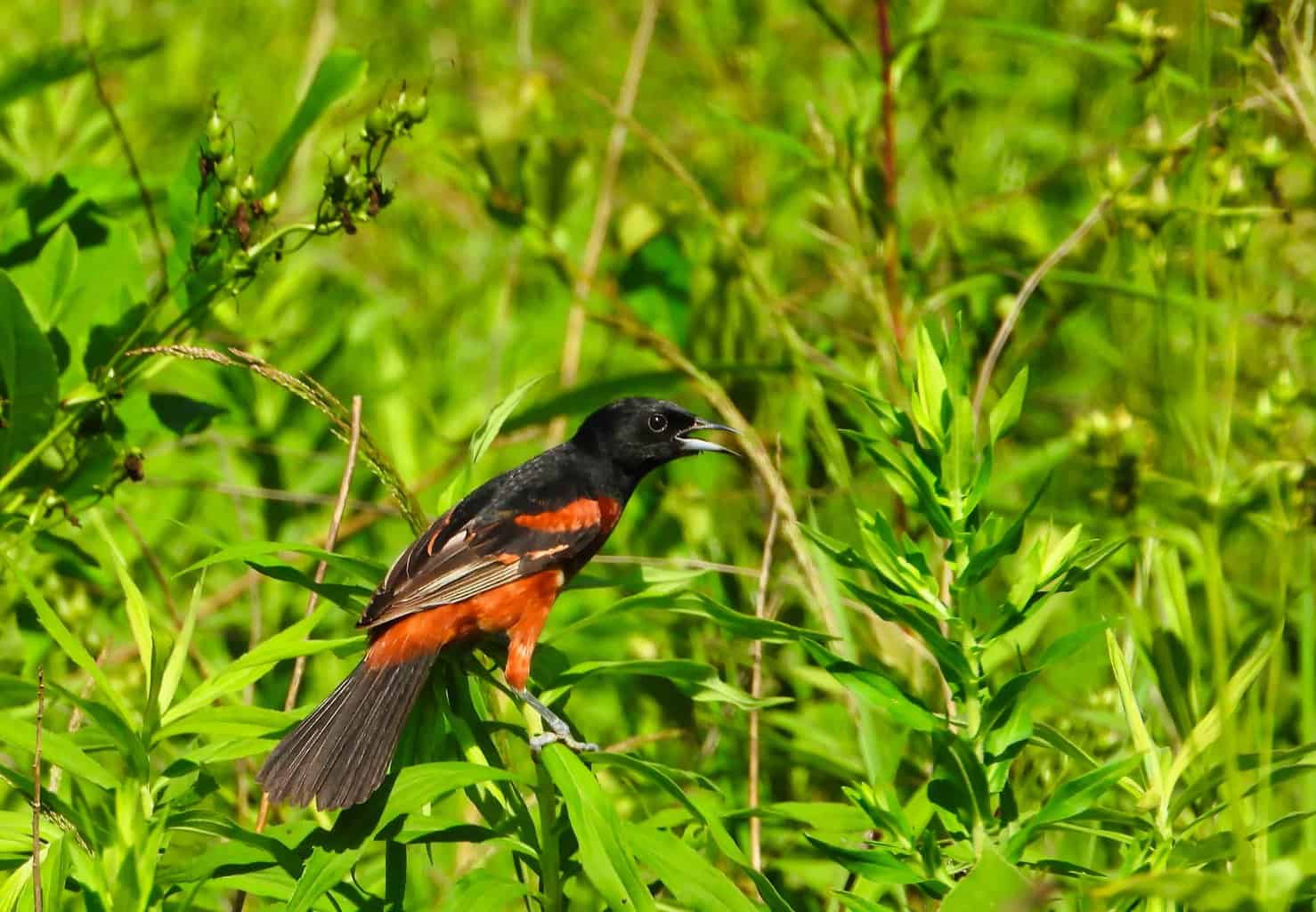
- Length: 5.9 – 7.1 in (15 – 18 cm)
- Weight: 0.6 – 1.0 oz (16 – 28 g)
- Wingspan: 9.8 in (25 cm)
Color Pattern: The adult male is black on top from hood to tail, with a deep chestnut-colored underside. There is a chestnut-colored patch on each wing, with a white wing bar.
The adult females have an olive-to-yellow back that gets more yellow on the underside. Their wings are grayish and marked with two white wing bars; unlike the males, they have no black markings.
Juveniles are similar to females, but immature males have black markings on their faces.
If you’re being visited by an Orchard Oriole, you might not realize it. These birds’ songs sound very similar to several other species, which can cause a case of mistaken identity.
Orchard Orioles don’t seem to mind though—they’re very easy-going amongst other orioles and birds of different species.
These birds are also social with each other, preferring to nest close together and often sharing the same tree, as long as conditions in the area are favorable.
Red-Winged Blackbird
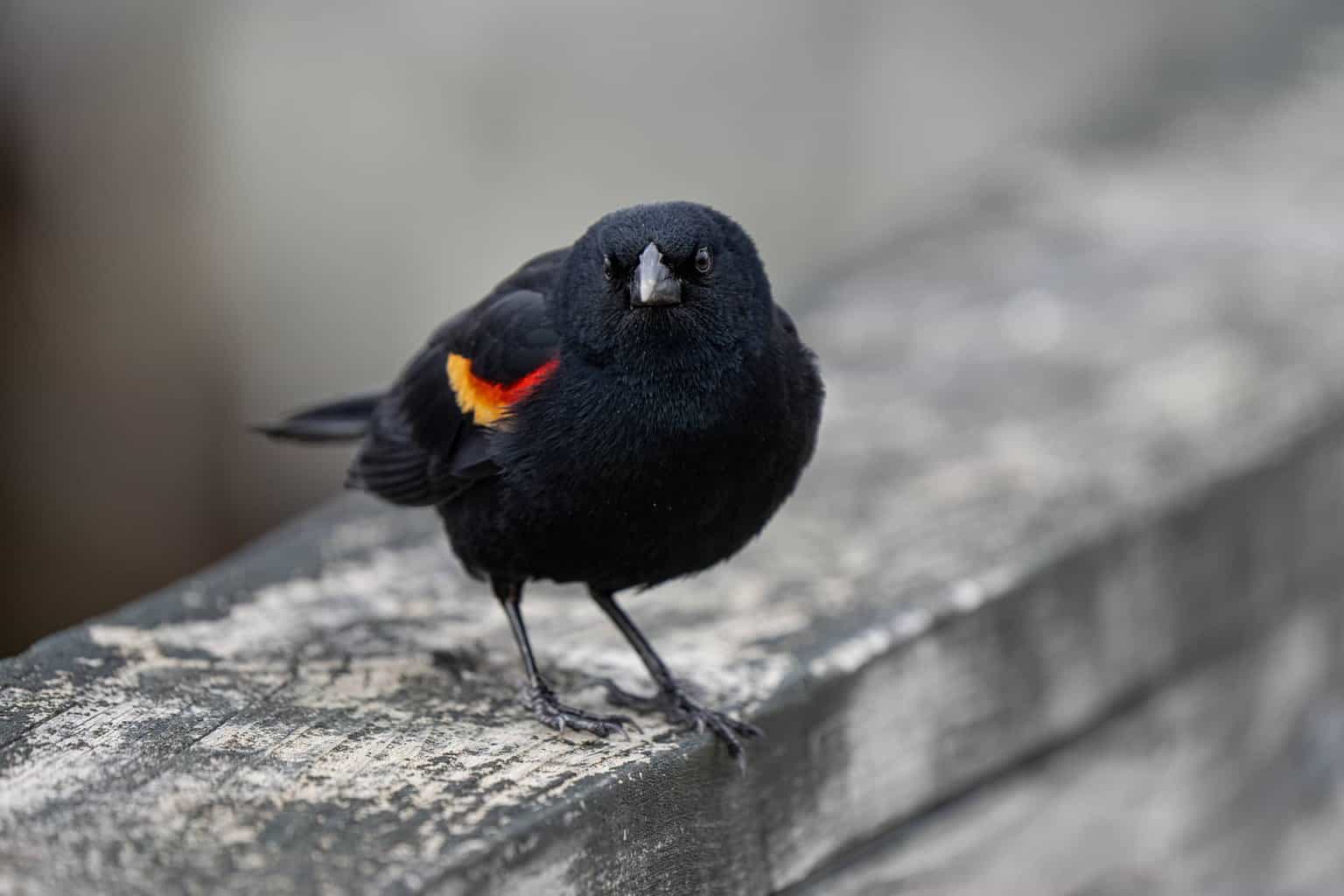
- Length: 6.7 – 9.1 in (17 – 23 cm)
- Weight: 1.1 – 2.7 oz (32 – 77 g)
- Wingspan: 12.2 – 15.8 in (31 – 40 cm)
Color Pattern: The adult males are striking in appearance, with glossy black bodies, and red and yellow markings on the curve of each shoulder.
Females are dark brown overall, with clean white wing bars, a pale breast, and often, a white eyebrow.
Like many members of the blackbird family, Red-Winged Blackbirds just can’t get enough water. They favor marshy areas, wetlands, and even a ditch in a field!
During the breeding season, adult male Red-Winged Blackbirds become extremely territorial, defending a territory of as many as 15 female mates against all comers—whether birds, animals, or humans.
Despite their efforts, anywhere from one-quarter to one-half of the chicks in a given nest will have been fathered by a different adult male than the one defending the territory.
Bronzed Cowbird
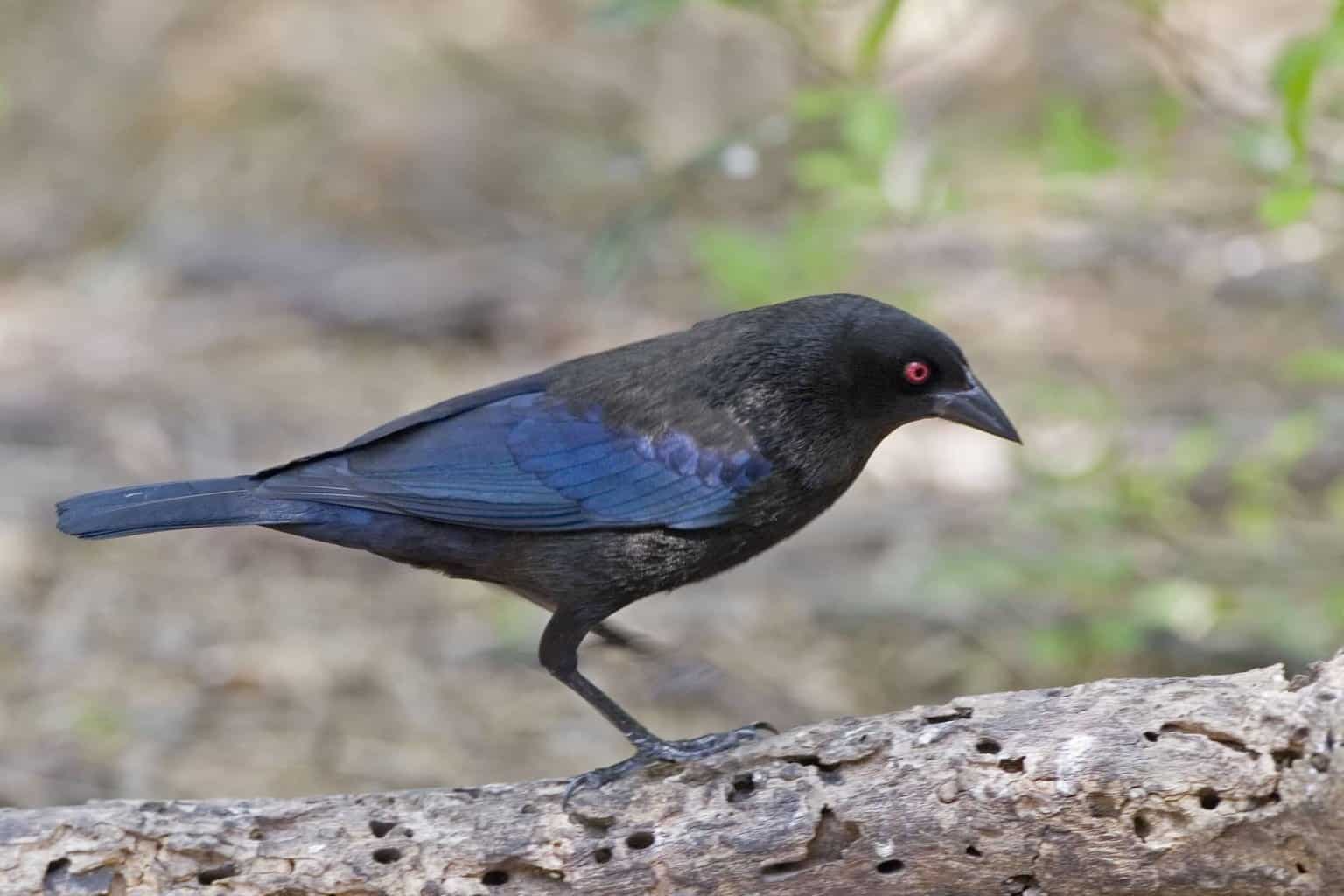
- Length: 7.9 in (20 cm)
- Weight: 2.3 – 2.6 oz (64.9 – 73.9 g)
- Wingspan: 13.0 in (33 cm)
Color Pattern: Adult males are black all over with a bronze sheen. Their wings can flash blue-to-purple up close. They frequently fluff their nape feathers in a display that makes their necks appear very thick.
Females and juveniles in the eastern part of the Bronzed Cowbird’s range are brown all over with blackish shading; in the western range, they’re grayish.
Adult Bronzed Cowbirds all have bright red eyes; juveniles have dark eyes.
Bronzed Cowbirds have extended their range dramatically since the 1950s. The first record of a Bronzed Cowbird in Louisiana was in 1961.
Bronzed Cowbirds are rarer summer visitors to Louisiana, but they are fascinating ones.
Instead of building their own nests, they lay their eggs in the nests of other birds. As many as 17 Bronzed Cowbird eggs have been found in a single nest!
Brown-Headed Cowbird
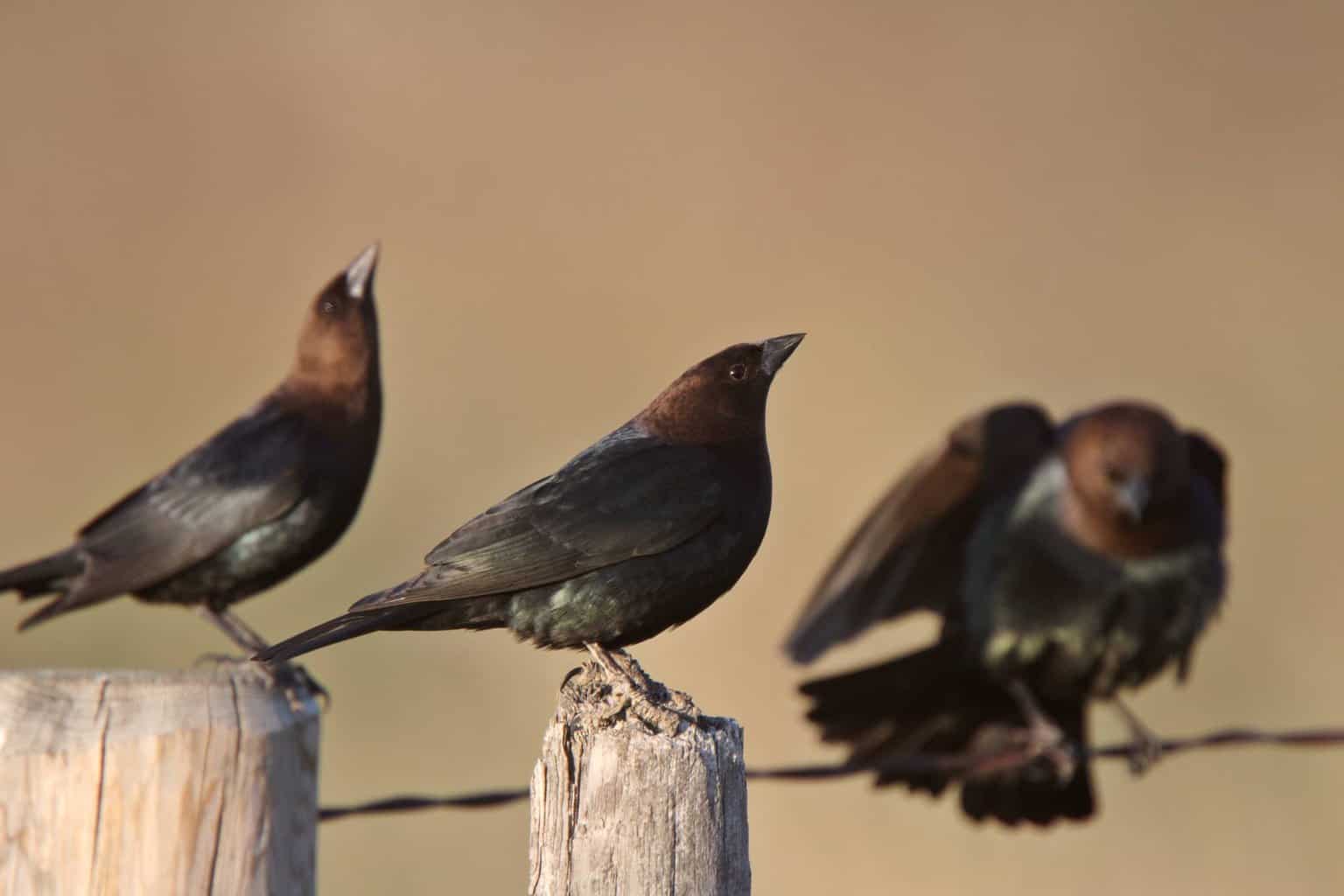
Male
- Length: 7.5 – 8.7 in (19 – 22 cm)
- Weight: 1.5 – 1.8 oz (42 – 50 g)
- Wingspan: 14.2 in (36 cm)
Female
- Length: 6.3 – 7.9 in (16 – 20 cm)
- Weight: 1.3 – 1.6 oz (38 – 45 g)
- Wingspan: 12.6 – 15.0 in (32 – 38 cm)
Color Pattern: Adult males have glossy black feathers all over their bodies, and a deep brown head that can look black from a distance.
Females are entirely brown, but lighter on their heads and undersides. They have dark eyes and fine streaks on their bellies.
The most distinctive trait of Brown-Headed Cowbirds is that, like the Bronzed Cowbirds, they are brood parasites: that is, they lay their eggs in other birds’ nests. They then make their chicks someone else’s problem!
What’s really interesting, though, is that not all birds helplessly raise the Cowbirds’ chicks as their own.
Some species have learned to recognize the intruder’s eggs and created defenses against them, such as puncturing the eggs or building a new nest.
Rusty Blackbird
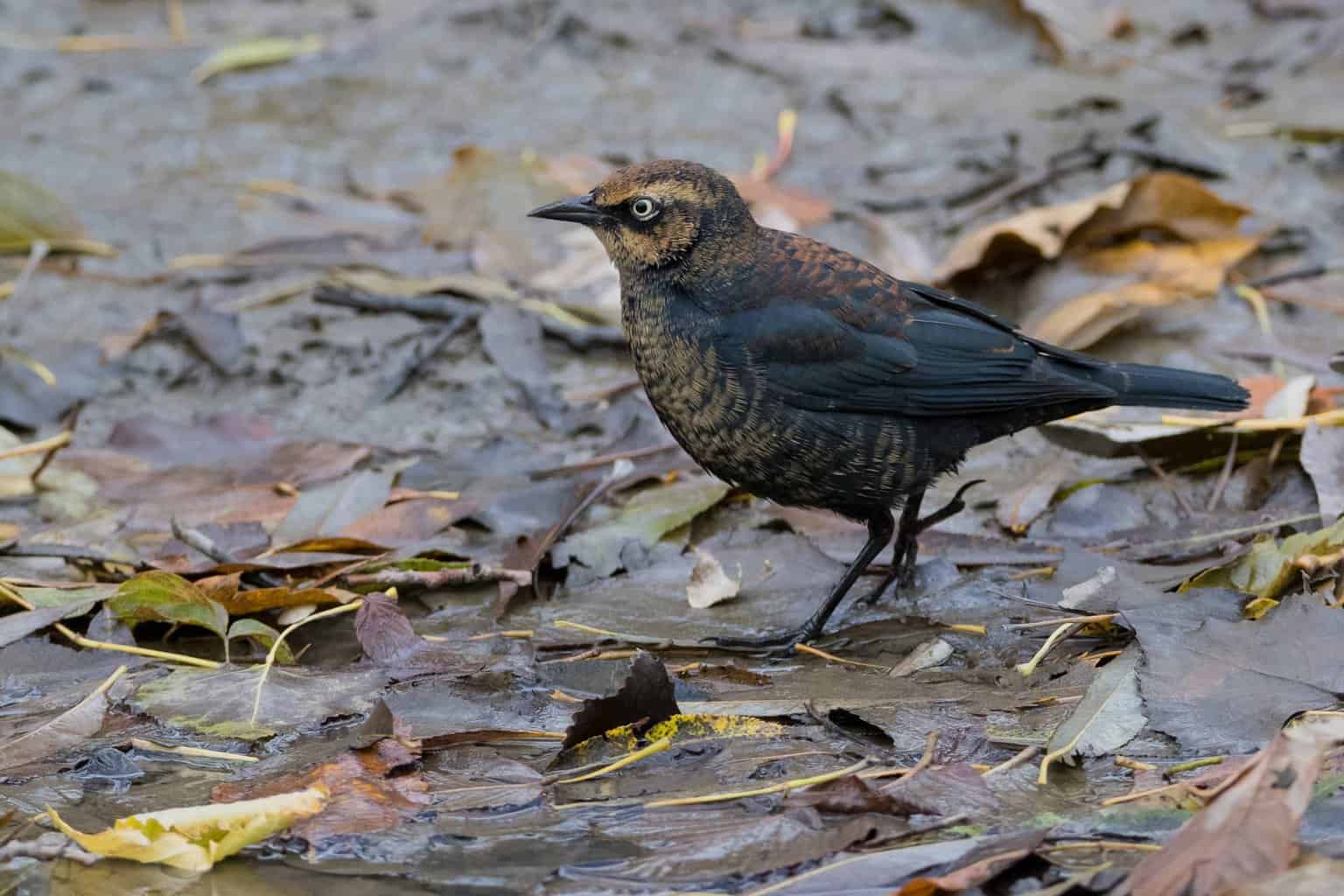
- Length: 8.3 – 9.8 in (21 – 25 cm)
- Weight: 1.7 – 2.8 oz (47 – 80 g)
- Wingspan: 14.6 in (37 cm)
Color Pattern: The Rusty Blackbird is recognizable by the rusty feather edges that are visible on both the non-breeding adult males and the females. Both also have pale yellow eyes. Non-breeding males have buffy eyebrows.
Females have gray-brown bodies and dark feathers surrounding the eye that contrast with a pale brow.
Breeding males are glossy black all over, with a greenish iridescent sheen.
Rusty Blackbirds winter in Louisiana and other parts of the south. Their preferred habitat is flooded bottomland forest areas in the Mississippi River Valley and along the East Coast.
This wintering ground and its critical wetlands habitats may hold the key to saving this unique bird.
The Rusty Blackbird is in serious trouble. This bird’s numbers declined 85% to 95% over a span of 40 years—more than any other North American songbird.
Frustratingly, no one is certain why. Factors that could be contributing to the extinction of Rusty Blackbirds include habitat loss, mercury toxicity, pesticide runoff, and climate change causing wetlands to dry up.
The International Rusty Blackbird Working Group is studying these birds and trying to solve the troubling problem of their decline.
Brewer’s Blackbird
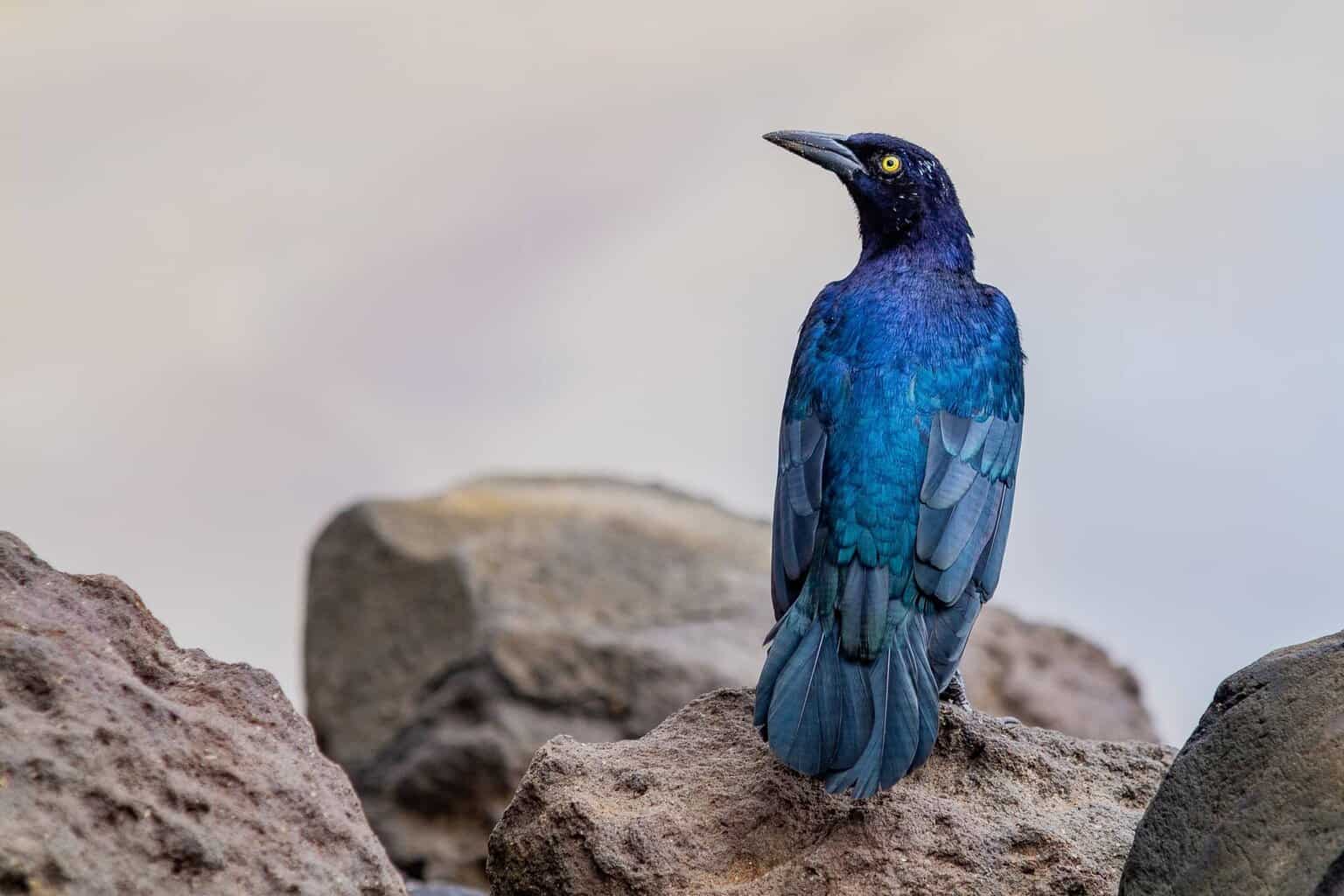
Male
- Length: 8.3 – 9.8 in (21 – 25 cm)
- Weight: 2.1 – 3.0 oz (60 – 86 g)
- Wingspan: 14.6 in (37 cm)
Female
- Length: 7.9 – 8.7 in (20 – 22 cm)
- Weight: 1.8 – 2.4 oz (50 – 67 g)
- Wingspan: 14.6 in (37 cm)
Color Pattern: Adult males are iridescent black that ranges from blues at the top of their head, down to greens lower on their body. They have striking yellow eyes.
Females are brown throughout, but darker on their tails and wings. They have dark eyes. Juveniles will look similar to the females, but with washed-out coloration.
Brewer’s Blackbirds are sometimes thought to be agricultural pests because they eat grains, but they’re actually really important for controlling populations of pest insects.
They eat a variety of troublesome insects, including tent caterpillars, termites, and weevils.
As you might know, if you play the popular bird-themed game Wingspan, Brewer’s Blackbird is named for a 19th-century ornithologist and oologist, Thomas Mayo Brewer.
Common Grackle

- Length: 11.0 – 13.4 in (28 – 34 cm)
- Weight: 2.6 – 5.0 oz (74 – 142 g)
- Wingspan: 14.2 – 18.1 in (36 – 46 cm)
Color Pattern: Common Grackles seem to be simply black, but iridescence gives them a wide array of colors under the right light.
Adult males have glossy purple heads and bronzing all over their bodies. Females aren’t as iridescent as the males, but still have some of that bronzing and multicolored sheen.
Both adults have a light golden eye, but juveniles are born with a dark eye.
Common Grackles are intelligent, noisy birds that are known for their wide-ranging appetites and foraging skills.
These highly-social birds will form multi-species flocks in the winter with other types of blackbirds, sometimes including several million birds. They forage and roost together.
Great-Tailed Grackle
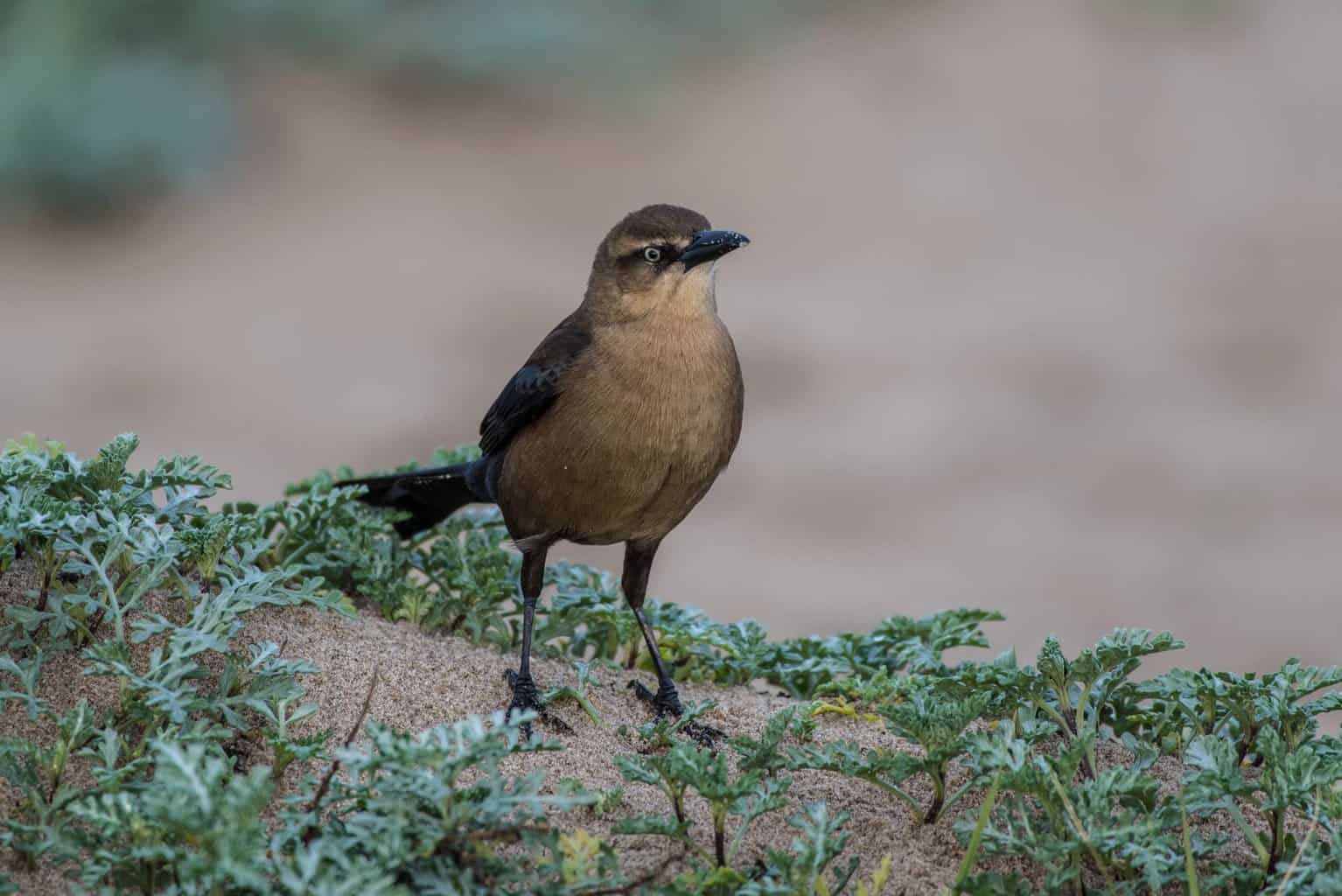
- Length: 15.0 – 18.1 in (38 – 46 cm)
- Weight: 3.7 – 6.7 oz (105 – 190 g)
- Wingspan: 18.9 – 22.8 in (48 – 58 cm)
Color Pattern: Males are black all over, including their bills and legs. Their feathers are iridescent. They have vivid yellow eyes.
Females are dark brown all over, with lighter undersides and buff-colored throats. They have a dark eye with a stripe above. The immature birds share the female’s coloration, with streaking on their undersides.
Although you won’t see Great-Tailed Grackles all that often in Louisiana, they do reside in the state year-round.
Great-Tailed Grackles are incredibly smart and social birds. They’ve been demonstrated to recognize individual human scientists during research projects and give special calls to them.
Great-Tailed Grackles will roost together in flocks of up to 500,000 birds, staying together in roost trees that allow them to enjoy each others’ company.
Concluding Thoughts
Louisiana’s waterways and warm weather offer ideal habitats to a wide variety of blackbird species. That means lots of opportunities for you to observe these intelligent birds and their unique behaviors. Happy birding!

